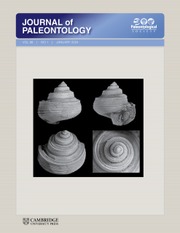No CrossRef data available.
Article contents
Early Carboniferous athyridid brachiopods from the Qaidam Basin, northwest China
Published online by Cambridge University Press: 20 May 2016
Abstract
Four new Early Carboniferous athyridid species in three genera, including one new genus, Bruntonathyris, are described from the Qaidam Basin, northwest China: Lamellosathyris qaidamensis, Bruntonathyris amunikeensis, Bruntonathyris? heijianshanensis, and Lochengia qinghaiensis. Based on the new material and also on published information, we also reviewed the taxonomic composition and the stratigraphic and paleogeographic distributions of the three genera. As a result, Lamellosathyris is considered to be indicative of late Famennian to Viséan age, originating in late Famennian in central North America and Armenia of Russia, respectively. Later, the genus appears to have two migratory directions: one branch rapidly dispersed over Mississippi Valley, Oklahoma, Texas and New Mexico of central North America in Tournaisian; alternatively, another branch from Armenia migrated westerly to Belgium, France, Spain, Britain, Ireland, via the Moscow Basin and Ural seaway, eastward to the Tienshan Mountains and Qaidam Basin of northwest China during the Tournaisian to Viséan, and easterly along the southern shelves of the Paleo-Tethys to Iran and western Yunnan of southwestern China in Tournaisian. Both Bruntonathyris and Lochengia are restrictedly Tournaisian to Viséan in age, and probably originated in the Qaidam Basin. Later, Bruntonathyris migrated easterly to South China and Japan, and westerly to Urals, Moscow Basin, Donetsk Basin and Britain; Lochengia migrated easterly to South China and westerly to the Urals seaway and the adjoined Russian Platform (i.e., both the Moscow and Donetsk Basins).
- Type
- Research Article
- Information
- Copyright
- Copyright © The Paleontological Society




